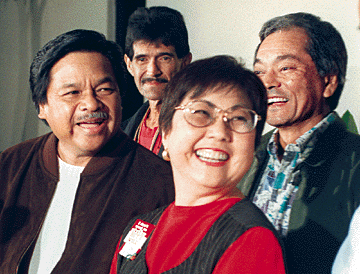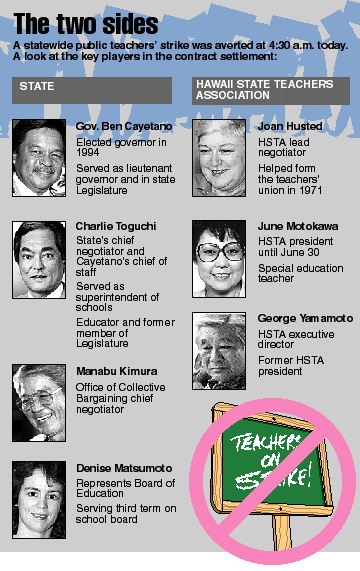
By Dean Sensui, Star-Bulletin
Announcing this morning's deal are Gov. Ben Cayetano,
school board member Ron Nakano, teachers union President
June Motokawa and state negotiator Charles Toguchi.



The four-year pact, worked out all night, was tentatively agreed to at 4:30 a.m. The Hawaii State Teacher Association’s 11,700 members had been set to strike at 5 a.m.
Although the walkout was averted, classes were canceled for today. Department of Education administrators had made that decision last night. Classes were to resume tomorrow.
“I’m pleased that after three long years of bargaining, we were able to reach an agreement which will benefit teachers and the public school system,” Hawaii State Teacher Association president June Motokawa said.
The pact would raise teachers’ base pay a little more than 17 percent through a combination of salary hikes and by paying them to work seven extra days. The longer school year begins in September 1998. The deal will cost the state about $100 million, said Gov. Ben Cayetano.
By Feb. 1, 1999, entry-level salaries will rise to $29,204 from $25,436, according to HSTA. Top-level salaries will jump to $58,167 from $50,606. Average salaries will increase to $41,396 from $35,800.
The breakdown of salary increases, according to HSTA: 7.9 percent across the board in 1997; 5-5.22 percent through step movement and across-the-board increases in 1998; and 2.25-4 percent across the board in 1999. There will be no retroactive increases for the 1995-96 school year.
“I don’t know of any worker in the state getting that kind of raise with the exception of maybe bankers,” Cayetano said.
The union said the pact also created new “instructor” classes for hirees who are not properly certified as teachers. Teachers currently in service who do not hold education degrees will be grandfathered in.
Teachers in Class VII who hold doctoral degrees will receive a 6 percent differential above the new Class VI salary.
Although union leaders had resisted the longer work year, they agreed after the state substantially increased its salary offer. The union also won all its “noncost” demands, said lead HSTA negotiator Joan Husted. Those include:
 Allowing teachers to take five days from their already allocated sick leave for professional development or personal leave.
Allowing teachers to take five days from their already allocated sick leave for professional development or personal leave.
 Allowing teachers to take their 45-minute preparation period where and when they decide.
Allowing teachers to take their 45-minute preparation period where and when they decide.
 Creating a blue-ribbon commission to investigate why teacher morale is so low.
Creating a blue-ribbon commission to investigate why teacher morale is so low.

Relief was palpable as word of the settlement spread.
“It’s one of the most exciting phone calls I’ve ever gotten in my life,” Greg Van Cantfort, a teacher at Kalani High School and strike coordinator for the Kahala-Aina Haina complex said after hearing the news today.
He and his colleagues had been getting ready to walk the picket line when they were called off. “This is a humongous victory for teachers and the profession here in Hawaii.”
As part of the deal, which is to be put to a ratification vote on Feb. 28, teachers were given the day off today. Many had been up practically all night getting ready to strike.
“What a relief. ... It’s been a difficult period for everyone and now we need to get to the business at hand, moving education forward in Hawaii,” said Board of Education Chairwoman Karen Knudsen.
With negotiations going down to the wire, state Superintendent Herman Aizawa last night ordered classes canceled so the more than 188,000 students and their families would not have to scramble so much this morning.
Many were scrambling anyway, for alternate child care. As of yesterday evening, 2,422 kids had registered for the city’s free “Winter Fun” parks program. Private providers also were taking in youngsters today.
Although students and teachers have today off, other Department of Education employees were expected to report to work since the strike was averted, Aizawa said.
Cayetano joined the talks for about 2-1/2 hours last night and said he would have to drop three of his tax reform proposals -- proposed tax breaks for college tuition, certain first-time homebuyers and overseas consultant services contracts -- to finance the contract.
“It would be a shame, given this offer, for a strike to occur,” he said then. “This offer is a very generous one and, under the circumstances, is the best we can do.”
His goal was to make a “distinct and significant” change to education in the state by providing children more time in the classroom.
“The young people of our state need to get something out of this contract and that’s what the extra days are all about,” he said.
Said Aizawa this morning: “The settlement is one that everybody will appreciate. . . . The highlight is the additional seven days of instruction time. That’s something that will directly help students and their families.”
The deal is considerably better than the state’s initial offer of no retroactive pay raises for 1995 and 1996, 4 percent hikes each of the next two years, plus pay to add 10 school days over the next two years.
Union leaders earlier had sought a straight pay hike of 20 percent over four years and resisted combining the package with money for extra work.
The history of the deal
Nov. 14, 1994: State and Hawaii State Teachers Association begin negotiating a renewed teacher contract.
June 30, 1995: Teachers' contract expires but is extended for the first of five times over the next 16 months.
May 7, 1996: HSTA declares an impasse in contract negotiations.
May 13, 1996: The Hawaii Labor Relations Board declares an impasse in negotiations and appoints a mediator. No agreement is reached on any proposals during mediation.
July 23, 1996: A fact-finding committee appointed by the Labor Relations Board recommends a one-time, across-the-board 10 percent raise for teachers at an estimated cost to the state of $26 million for half of fiscal year 1997, and $46 million for fiscal year 1998. The HSTA supports the nonbinding recommendation; the Department of Education rejects it. The report starts the clock ticking on a 60-day "cooling off" period during which no strike vote can take place.
Sept. 22, 1996: The cooling-off period ends.
Oct. 10, 1996: Gov. Ben Cayetano names his chief of staff, Charles Toguchi, a former state schools superintendent and HSTA staffer, to head the state's negotiating team in hopes of reviving stalled talks with the union.
Oct. 12, 1996: HSTA's board of directors votes not to extend the contract when it expires Oct. 31, 1996.
Oct. 31, 1996: The contract expires, leaving the union free to call a strike on 10 days' notice.
Jan. 10: HSTA's board of directors votes 44-1 to call a strike authorization vote among the union's 11,700 members.
Feb. 6: Teachers authorize a strike by a margin of 97.7 percent to roughly 2 percent.
Feb. 8: HSTA board sets a strike date for Feb. 20.
Feb. 20: State, HSTA settle contract dispute at 4:30 a.m. with a new $100 million, four-year contract.
Teachers hail victory